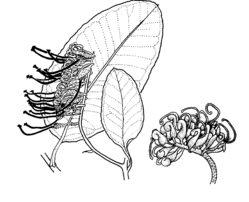Common name: Laurel-leaf Grevillea
Grevillea laurifolia Sieber ex Spreng. APNI* 
Description: Prostrate trailing shrub.
Leaves simple, ovate to oblong or elliptic, sometimes cordate, mostly 3–12 cm long, 2–6 cm wide; margins entire to crenulate; lower surface silky, rarely almost glabrous.
Inflorescences secund to semicylindrical, 2–8 cm long. Perianth light red to maroon, subsericeous outside, glabrous inside. Gynoecium 13–25 mm long; ovary densely hairy; style red, glabrous, pollen presenter erect to oblique.
Follicle hairy with reddish brown stripes or blotches.
Flowering: spring to autumn, mainly September–January
Distribution and occurrence: Grows in open woodland or dry sclerophyll forest, on ridges and slopes in sandy to clayey soils on sandstone and quartzite; the lower Blue Mtns and on the ranges from Newnes to Wombeyan Caves.
NSW subdivisions: CC, CT
At lower elevations (Wentworth Falls to Warrimoo), flowers are smaller and deep maroon, in more compact semicylindrical conflorescences.
In combination with G. acanthifolia subsp. acanthifolia the species produces natural hybrids known as G. X gaudichaudii, which have lobed leaves.
Text by R. O. Makinson
Taxon concept: R.O. Makinson (2000)
APNI* Provides a link to the Australian Plant Name Index (hosted by the Australian National Botanic Gardens) for comprehensive bibliographic data
***The AVH map option provides a detailed interactive Australia wide distribution map drawn from collections held by all major Australian herbaria participating in the Australian Virtual Herbarium project.
|


